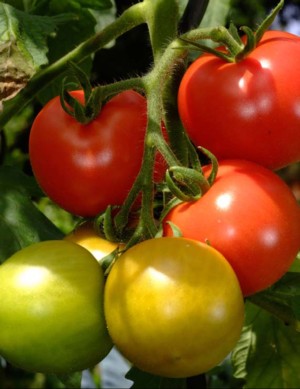A guide to growing tomatoes in your backyard
Homegrown wonders
Of all the homegrown vegetables, tomatoes must be the most popular and possibly most rewarding to grow. The varieties are endless in colour, size, shape and even taste. From the smallest cherry tomato to the largest oxheart, there is a type for all backyard gardens. Names such as Beams Yellow Pear, Green Zebra, Mortgage Lifter, Tiny Tim, Apollo, Tigerella, Grape and Black Russian are enough to give even the most inexperienced novice a description of what will be produced by these vines. Gross Lisse is one of the most popular varieties and Roma is a favourite for Italian cooking. Each has its own distinct flavour but, as anyone who has grown them will tell you, homegrown tomatoes all taste fantastic regardless.
You can never have too many tomatoes as they can always be used in sandwiches, pasta, chutneys, salads, stews and soups as well as being frozen, dried or preserved. When grown up an attractive support, they add interest and colour to the vegetable garden and can also be grown in pots. Most tomatoes grown for sale in supermarkets today have been bred to have tougher skins to survive transport, but at the cost of flavour, so why not grow your own and experience the difference?
Grafted tomatoes
One way of combating any diseases tomatoes may develop is to buy grafted tomatoes. These have a rootstock that’s more disease-resistant and a cutting, or “scion”, from a chosen tomato species is grated onto it. Any shoots coming from under the graft will be coming from the rootstock and should be removed as they will steal nutrients away from the scion and will seriously inhibit its growth. Grated plants also produce masses of tomatoes.
Pests
The most common pests that will attack your tomatoes will be green looper caterpillars and white flies. A natural insecticide made from soap, water and chilli or garlic will help to control the looper numbers without adding harsh chemicals to your garden. A simple piece of plywood can cut down the white fly population. White flies are small insects that are attracted to the yellow tomato flowers and suck the juices from the plant, causing leaves to yellow. In large numbers, they can have an adverse effect on your crop. If a piece of plywood or plastic is painted yellow, smeared with Vaseline and hung in the vegie garden near the tomatoes, the white flies will be attracted to it and become stuck in the Vaseline and die.
Companion planting
Natural insect repellents keep pests at bay without the use of chemicals. Growing garlic, onions, shallots or chives under tomatoes will not only keep harmful insects away because of their strong odour but will also provide more produce for the kitchen. Pyrethrum daisies and marigolds planted between the rows will also deter pests.
Fertilising
There are many all-round natural fertilisers on the market that will keep your tomatoes fit and healthy and, as they are gross feeders, they will need to be fed every two weeks. A nitrogen fertiliser will give tomatoes strong stems and leaves in their early days but when the first flower truss begins to form fruit, use a potassium fertiliser as this will help the tomatoes form. If you have a wood-burning fire, the wood ash contains potassium and some of this can be dug in around the roots of the plants, as can egg shells, which are high in calcium and help to prevent end blossom rot.
Tips: Most tomato varieties require staking and the stake should be placed in position first before planting the tomato alongside it. If you plant first and then try to positionv the stake, you may hammer it through the roots of the tomato, damaging the plant and leaving it susceptible to disease. The plant is then tied to the stake with soft cloth or old stockings in a figure-eight style with the cloth going around the plant, crossing over itself between the plant and the stake and then being tied around the stake. When to sow: From September to November in cool climates, August to December in temperate locations and most of the year in warmer areas. Spacing: Plant 3–4 seeds at each location 50cm apart in rows 90cm apart and thin to the strongest seedlings, or start seedlings in punnets indoors as the weather warms to plant out later. Depth of planting: Plant seeds 0.5–1cm deep. Time from planting till harvest: 12–16 weeks.
Tips: To allow your tomatoes to grow stronger and support themselves more easily, as well as increase their output many times over, plant as deeply as possible with just the leaves above the surface. The stem will send out roots underground where it is in contact with the soil, which will anchor it into the ground with a larger root structure.
Tomato & Vegie Frittata
Ingredients
- 1 or two large tomatoes (any variety)
- ½ capsicum
- 4–5 button mushrooms
- 1 zucchini
- 3–4 spears asparagus
- Thyme, basil & chives
- 8 eggs
- 2 cups milk (add more if needed to cover vegetables)
- 1 cup grated parmesan cheese
- Salt & pepper
Preheat oven to 180°C. Chop all vegetables to roughly the same size, except tomatoes. Cut tomatoes into rings to garnish top of frittata. Arrange vegetables in ovenproof dish. Whisk eggs and milk in a separate bowl then pour over vegies. Top with grated parmesan, herbs and salt and pepper. Bake for 45–60 minutes until set and golden-brown on top.





